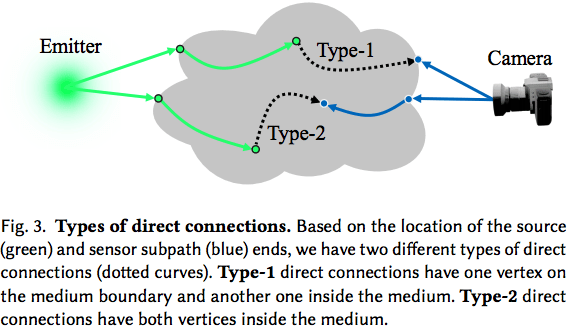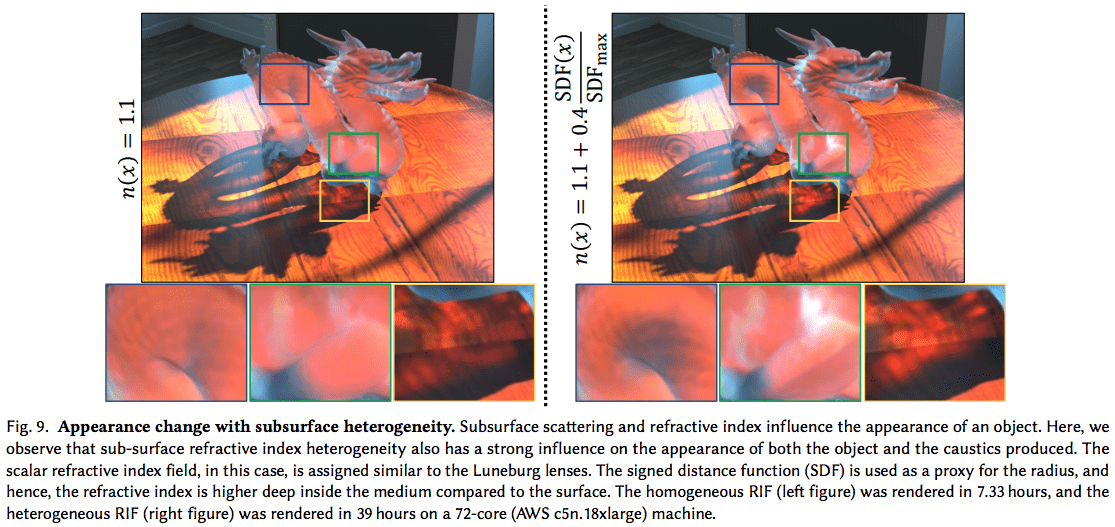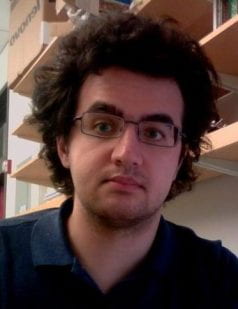Path Tracing Estimators for Refractive Radiative Transfer

Rendering radiative transfer
Rendering radiative transfer through media with a heterogeneous refractive index is challenging because the continuous refractive index variations result in light traveling along curved paths. Existing algorithms are based on photon mapping techniques, and thus are biased and result in strong artifacts. On the other hand, existing unbiased methods such as path tracing and bidirectional path tracing cannot be used in their current form to simulate media with a heterogeneous refractive index. We change this state of affairs by deriving unbiased path tracing estimators for this problem.
A path-integral formulation
Starting from the refractive radiative transfer equation (RRTE), we derive a path-integral formulation, which we use to generalize path tracing with next-event estimation and bidirectional path tracing to the heterogeneous refractive index setting. We then develop an optimization approach based on fast analytic derivative computations to produce the point-to-point connections required by these path tracing algorithms. We propose several acceleration techniques to handle complex scenes (surfaces and volumes) that include participating media with heterogeneous refractive fields. We use our algorithms to simulate a variety of scenes combining heterogeneous refraction and scattering, as well as tissue imaging techniques based on ultrasonic virtual waveguides and lenses. Our algorithms and publicly-available implementation can be used to characterize imaging systems such as refractive index microscopy, schlieren imaging, and acousto-optic imaging, and can facilitate the development of inverse rendering techniques for related applications.
Refractive radiative transfer equation (RRTE)
More Info
Light transport in heterogeneous refractive media is described using the refractive radiative transfer equation (RRTE) [Ament et al. 2014; Ihrke et al. 2007] that, in addition to light bending due to continuous refraction, also models effects due to volumetric and surface scattering. The light bending effects make this equation significantly more challenging to simulate than its counterpart for homogeneous refractive media, the radiative transfer equation [Novák et al. 2018].
Unbiased & Efficient
More Info
Our optimization-based technique in its simple form would only find one of these paths, resulting in bias, and is not practical for enumerating all stationary paths. To ensure unbiasedness and maintain efficiency, we introduce a Monte Carlo technique that forms an unbiased estimate of the total throughput through multiple stationary paths, through repeated random reinitializations of our gradient-based optimization algorithm. To further improve efficiency, we show how to accelerate direct connections using techniques similar to sphere tracing of signed distance functions [Hart 1996], and inside-outside tests based on fast winding numbers [Barill et al. 2018].
High Accuracy
More Info
We have implemented these algorithms within a physically-based renderer [Jakob 2010], and validated the accuracy of our implementation using simple scenes with known solutions, as well as real measurements (Figure 1, Section 7). Compared with previous photon mapping techniques, our algorithms can accurately and efficiently reproduce important effects, such as surface and volumetric caustics from gradient-index (GRIN) optics. Our algorithms are also straightforward to extend for time-of-flight rendering and spectral rendering.



People

Adithya Pediredla

Yasin Karimi Chalmiani

Matteo Giuseppe Scopelliti

Maysam Chamanzar

Srinivasa Narasimhan

IOANNIS GKIOULEKAS
